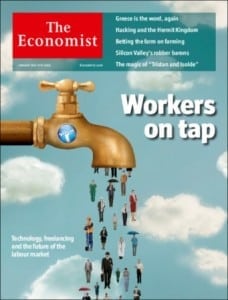This week’s guest post is brought to you by freelance writer Charles Franklin, who has amassed a top-rating, 1293 hours, and 128 projects on Upwork. Charles is a self-professed college dropout, who became a successful marketing freelancer after starting out with only $10 in his bank account.
Welcome to the freelance economy.  It’s here already. In fact, close to one-third of the U.S. workforce is gathered around the kitchen table instead of the water cooler, and pajamas are now considered commonplace on Casual Fridays.
It’s here already. In fact, close to one-third of the U.S. workforce is gathered around the kitchen table instead of the water cooler, and pajamas are now considered commonplace on Casual Fridays.
Because of evolving smart phone technology apps and an up-and-coming workforce with different priorities, this shift has become inevitable. Today’s professionals have more options, less overhead, and fewer barriers to entry overall.  Thus, it’s no surprise that we’ve seen articles appear in Forbes, The Economist, The Washington Post, and The Atlantic heralding a future wherein an “on-demand” workers are the norm.
Thus, it’s no surprise that we’ve seen articles appear in Forbes, The Economist, The Washington Post, and The Atlantic heralding a future wherein an “on-demand” workers are the norm.
But is freelancing right for everyone? If you’re one of those tempted to ditch the cube, read on.
The internet is full of optimistic articles that celebrate the perks of freelance living. However, like every business, freelancing has inherent risks. Freelancing isn’t all coffee shops and late nights on the laptop, as the stereotypes portray. It’s serious business and getting into it is akin to setting up shop in any field. In other words: it’s hard work.
The Dark Side: Facing Failure
“I’ll just get out and there, do my own thing, and be my own boss. What could possibly go wrong?” Well, failure (it seems) IS an option.
Freelancers don’t typically like to talk about it, but the fact is that they fail…and fail often. Between losing the client, not getting paid, and shelling out significant sums for fees and taxes, it’s easy to end up upside down in the 1099 world.
Freelancers, just like other small business owners, typically fail because they have a shortfall somewhere.
With my own career, it took four years before I had the slightest clue as to why my workflow wasn’t what it could be. After some careful reflection, I identified four critical weak points: customer acquisition, delivery, marketing, and cash flow.
Customer Acquisition
I’ll let you in on a little secret. Getting your first customer is just as nerve-wracking as getting your hundredth. It does get easier, but the tension never goes away completely. To that end, try the following.
- Be Specific. Freelancers, especially beginners, often complicate matters when describing themselves to prospects. Instead, keep it simple. Focus on a simple statement that outlines: what you do (writer, programmer, etc.) and who you do work for (churches, accountants, etc.)
As a beginning writer, I focused on 700-word generalized articles that appealed to a very broad audience, and earned roughly $20 per article. When I started to tailor my topics and audience, however, giving social media advice to self-published authors, my rate went up to $200 for the very same word count.
- Watch Your Stats. Keep track of your vital information about customer acquisition, such as where potential clients learned about you in the first place. Note the channels that work (i.e. email, networking groups, social media, etc.) in order to identify trends over time. Notate the time between customers and whether the gap is getting smaller or longer. Knowing your seasonal peaks and valleys can help you plan out your annual finances.

Delivery
The way you deliver your service is part of a your unique package. Delivery consists not only of the end product, but also the method of hand-off. There are two ways to address this skillfully.
- Provide Formal On-boarding. When a new client signs up for your service, let them know exactly what to expect and when. This improves efficiency and aligns expectations on both sides.
- Make Satisfaction A Priority. All things being equal, the freelancer who does the job “best” will be the one chosen next time. Thus, knowing how satisfied your past clients have been can be an important competitive advantage. Consider offering a post-service survey so that you know where to improve.
In my second year of freelance writing, I offered a marketing and advertising service that helped authors maximize their use of Amazon’s KDP Select program. My promotional service sold like hotcakes for about a year before sales unexpectedly dried up. After getting the courage to ask my clients about why they left, I learned that they wanted more from me than just a one-time promotion. When I didn’t provide that additional help, they moved on. As a result, I missed a prime opportunity to exceed their expectations and, in the process, earn their repeat business and referrals.
Marketing
When it comes to on-demand work, marketing is a complicated subject, fraught with confusion and a distinct lack of specificity. Even so, you don’t have to leave it to chance.
- Look At Both Sides. Marketing involves both what you say about yourself (on social media, through advertising, etc.) as well as what people say about you (via online reviews and word of mouth). Both are essential and must be monitored closely.
- Focus On Trends. In general, you should see growth (i.e. more views, more responses, etc.) and regular conversion (e.g. sales). Monitor your marketing dollars by channel and note what offers the best return on investment.
Although in my own freelance business I attempted to generate leads on every social media channel possible, there were really only two places that worked: LinkedIn and my blog. Using that knowledge, I began to post consistently on LinkedIn and also engage directly with prospective clients on my blog. In less than three months, I saw an influx of more qualified leads.
Cash Flow
Money-in, money-out: it’s the lifeblood of freelancing. Of course, earning money is only part of the battle. You need money to pay yourself, pay your bills, and set aside some savings in order to survive.
- Make Pricing Simple. The basic rule of freelance pricing is this: sell your service high and work for only a few people OR sell your service at a budget price and work for a lot more folks. Either method can work…if you stick to what works for you.
- Monitor Your Accounts. Hire a bookkeeper or an accountant and get help creating a cash flow statement and balance sheet. Seeing these key indicators is the only way to know whether or not your freelancing business may be in trouble.
With the help of a financial planner, I reviewed the profitability of every freelance service that I offered. As a result, I decided to stop offering one-time promotional services and, instead, focused on a retainer service that offered marketing and advertising support packages, which were more personalized to each client’s needs. This provided me with a more steady source of income from higher-paying clients.
There’s no doubt about it, freelance work isn’t for the faint of heart. No time off, no benefits, and no interns to blame if you miss that deadline. But if you can do this, you can do anything. Now that you know the next wave is coming, get ready to surf and enjoy the ride.
 Charles Franklin is an almost-graduated college dropout (in Psychology and Social Work) turned marketing and writing freelancer, who came to Atlanta with only $80 in his pocket. Franklin developed a successful book marketing and public relations service after learning that jobs don’t grow on trees. His goal in life is to create a cycle of inspiration that will transform our economy and our environment into something beyond our wildest dreams.
Charles Franklin is an almost-graduated college dropout (in Psychology and Social Work) turned marketing and writing freelancer, who came to Atlanta with only $80 in his pocket. Franklin developed a successful book marketing and public relations service after learning that jobs don’t grow on trees. His goal in life is to create a cycle of inspiration that will transform our economy and our environment into something beyond our wildest dreams.



